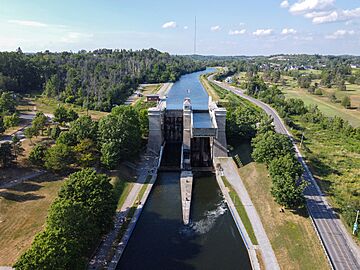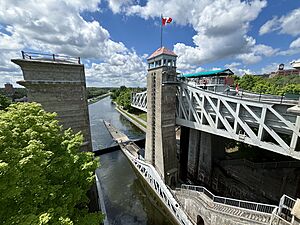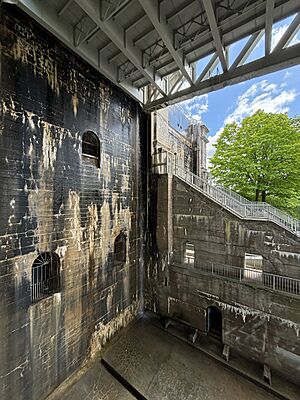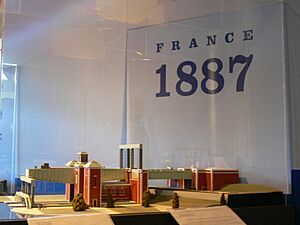Peterborough Lift Lock facts for kids

Aerial view of the Peterborough Lift Lock
|
|
| Waterway | Trent-Severn Waterway |
|---|---|
| Country | Canada |
| Province | Southern Ontario |
| Maintained by | Parks Canada |
| Operation | Hydraulic |
| First built | 1904 |
| Latest built | 1980s |
| Length | 43 metres (141 ft) |
| Width | 10 metres (33 ft) |
| Fall | 19.8 metres (65 ft 0 in) |
| Coordinates | 44°18′27″N 78°18′03″W / 44.30750°N 78.30083°W |
| Designated: | 1979 |
The Peterborough Lift Lock is an amazing machine that helps boats travel up and down a big hill of water! It's located on the Trent Canal in Peterborough, Ontario, Canada. This special lock is known as Lock 21 on the Trent-Severn Waterway.
For many years, the Peterborough Lift Lock was the tallest hydraulic boat lift in the world. It could raise boats an incredible 19.8 meters (65 feet)! This was a huge achievement in the early 1900s, especially since most regular locks only lifted boats about 2 meters (7 feet).
In the 1980s, a visitor centre was built right next to the lock. Here, you can try out interactive simulations that make you feel like you're going through the lift lock in a boat. There are also cool exhibits that show how this giant machine was built.
When winter arrives, the canal below the lift lock turns into a popular spot for ice skating. Both locals and visitors love to glide across the frozen water.
The Peterborough Lift Lock is so important that it was named a National Historic Site in 1979. Later, in 1987, it was recognized as a Historic Mechanical Engineering Landmark by the American Society of Mechanical Engineers.
There's another similar hydraulic lift lock on the Trent-Severn Waterway called the Kirkfield Lift Lock. It has the same size "bathtubs" for boats but doesn't lift them quite as high.
Contents
How the Lift Lock Works
The Peterborough Lift Lock uses two huge, bathtub-shaped containers called "caissons" to move boats. These caissons are exactly alike. Boats go inside one caisson to go up, or inside the other to go down.
Each caisson has gates at both ends that swing open and close. There are also gates on the canal itself, where it connects to the caissons. When a caisson lines up with the canal, its gates and the canal gates open together, letting boats in or out.
The Power of Water
Each caisson sits on a giant ram, which is like a huge piston. These rams go deep into the ground and are filled with water. The two rams are connected by a pipe with a special control valve. Rails on concrete towers guide the caissons smoothly up and down.
The caissons are very big: 43 meters (140 feet) long, 10 meters (33 feet) wide, and 2 meters (7 feet) deep. When a caisson is full of water, it weighs about 1,700 tonnes (1,700 short tons)!
Gravity Does the Work
What's really cool is that the lift lock doesn't need any outside power! It works only by gravity, using a principle similar to a counterweight. This means one caisson always goes up while the other goes down during each cycle.
Here’s how it happens:
- When a caisson reaches the top, it stops about 30 centimeters (12 inches) below the water level of the upper canal.
- The control valve closes, and the gates open. Water from the upper canal flows into the top caisson until the water levels are equal.
- This extra foot of water adds about 144 tonnes (144 short tons) to the top caisson, making its total weight around 1,844 tonnes.
- Boats that just went up leave the top caisson, and new boats wanting to go through enter either the top or bottom caisson.
- Once the boats are secure, all gates close. The valve connecting the two rams opens.
- Because the top caisson is now heavier (1,844 tonnes) than the bottom caisson (1,700 tonnes), its ram pushes down. This forces water from its shaft through the connecting pipe and into the shaft of the bottom caisson.
- This push lifts the bottom caisson up to the top!
- When the newly descended caisson reaches the bottom, its gates open. The extra water flows out, making its weight equal to the lower canal's water level. Boats then exit, and the cycle can begin again.
Building the Lift Lock
A Smart Design
The idea for this amazing lift lock came from Richard Birdsall Rogers. He was a superintendent for the Trent Canal. In 1896, he traveled to countries like France, Belgium, and England to study other boat lifts.
The project also had a bit of a political story. A federal election was happening, and the government wanted to quickly start the project to gain local support. Construction was approved and contractors were hired even before all the detailed plans were ready!
When the government changed, Richard Rogers was worried about his job. So, he released the building plans bit by bit. This clever move allowed him to stay on as the main designer.
Engineering Firsts
The Peterborough Lift Lock was truly groundbreaking. It was the very first lock ever built using concrete. At the time, it was also the largest structure in the world made with concrete that didn't have steel bars inside for extra strength.
The company Corry and Laverdure from Peterborough did the digging and built the concrete towers and lock. The Dominion Bridge Company from Montreal handled all the metal parts, like the rams and the huge caissons.
The lift lock was finished in 1904. It officially opened to thousands of people on July 9, 1904, and it's still working perfectly today!
See also
- List of boat lifts
- Canal lock





